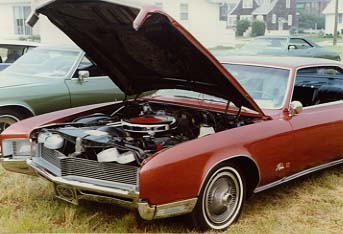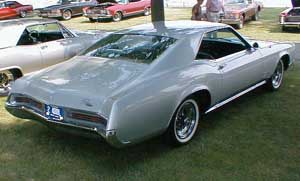1966 Buick Riviera
|
On September 22, 1965 Buick introduced a completely new
Riviera. The 1966 model was two inches longer and has a four-inch wider
tread than the previous year, due to the new frame designed to improve
the ride and handling. The new body featured a longer hood and fenders,
a more sloping windshield and modified fastback roof and deck. Car Life
magazine voted it the "handsomest car of 1966", noting that
there wasn't much wrong esthetically with the '65 version. "Where
earlier models had elegant plain lines, the new version has sweeping,
swooping, swinging lines with definite fender top and hood profiles." |
The design for the '66 was attributed to Buick's chief
designer Dave Holls. Holls had moved around GM working also with Chevrolet
and Cadillac where his designs influenced the '59 Cadillac, 60's Corvettes,
67-70 Camaro and '70 Monte Carlo. He retired in 1991, but keep very
active in the old car hobby. He passed away in June 0f 2000. |
|
The new design received high praise from many automobile
magazines for it's handling and flowing style. Most noticeable was the
absence of the window vents, which were made unnecessary with the introduction
of "Circulaire" a new ventilation system. Fresh air is taken
into the car through a grille in the hood, just in front of the windshield
and is exhausted though a similar grille under the rear window. Tests
had shown that this system would keep the interior of the car comfortable
in 70-degree plus temperatures without having to open a window. In keeping
with the disappearing headlamp feature inaugurated in '65 the '66 headlamps
are concealed above the radiator grille. When the headlamp switch is
turned on, the lights swing down into position in front of the grille. |
|
|
|
The grille is composed of nine thin horizontal bars, which extends into the parking lights located in the fenders. The name "Riviera" appears in block letters on the front edge of the hood. The horizontal bar design is carried over into the long taillights, which are surrounded by silver painted trim. Buick offered eight standard paint colors and seven "exclusive Riviera colors." They also doubled the amount of colors available for a vinyl roof to black or white, since only black was offered in '65. Based on our research only 7.2% of the buyers selected the vinyl top option. Besides the standard hubcap, a very stylish wire cap with a spinner was offered, as well as the option chrome wheel. The center cap on the chrome wheel was changed to a ribbed cone shape. All of the caps and wheels had a black center with a silver stylized "R". |
The interior had a whole new look and for the first time
a bench seat was available in a Riviera. In fact for the standard interior
you had a choice of either a bench or bucket front seat. The bench was
available in blue, black or dove vinyl, while the bucket was offered
only in black vinyl. The door on the standard trim was quite plain with
a small arm rest and a small-brushed aluminum panel. Those who paid
extra for the optional interior were treated to a larger variety of
colors as well as one of the most stylist door panels found in any car.
All of the optional seats had a back called "Strato", which
in effect was the same style used on the bucket seats. The optional
bench seats all had a pull down center armrest. The all vinyl bench
was offered in red, blue, green white or black. The cloth and vinyl
bench was offered in blue, black or plum. The optional bucket seats
were offered in blue, aqua, black or dove vinyl. The buckets could be
ordered with either a short storage console or a full wood trimmed console
with a floor shift. Headrests were offered for the first time and available
on either the bench or buckets. Once again the simulated wood wheel
was offered as an option. The dash was exclusive to the Riviera, which
had an unusual floating drum speedometer and gauges rather than warning
lights. Offered for the first time were automatic climate control and
a stereo AM/FM radio. |
|
 Optional "Strato" bench seat and upgraded door panel. |
A new cruciform frame was designed to accommodate the longer wheelbase along with an improved front and rear suspension. The rear suspension was redesigned by moving the springs from the lower control arms to the axle to effect greater control over "squat' on acceleration and lift during braking. Although it shared the same "E-body" frame with the Toronado, it remained a rear wheel drive, despite speculation that it might also convert to front wheel. The only engine offered was the 425ci, 340 hp, code "MW", with a single 4 bbl Quadra-jet carburetor. Initially the GS package included a single carburetor with a chrome air cleaner, with the aluminum valve covers, heavy-duty suspension, posi-tracion, 3.42 rear axle, whitewalls or red line tires and GS monograms on the fenders and on the glove box. Until March of '66 the dual four option was only available as a dealer option, after which it could be ordered from the factory and had a "MZ" engine code. |
|
Production was 45,348 at a base price of $4,424 with the standard equipment including power brake, steering, automatic transmission, dual exhausts and so much more. The most popular options were power windows installed in 78.6 % and air conditioning in 74.9%. Other popular options included the stereo AM/FM radio with dual speakers and power antenna $264.91, cornering lights $33.68, vacuum operated door locks $44.73, automatic climate control $484.00 reclining passenger seat with headrests $84.20 and the GS option $176.82. | |



